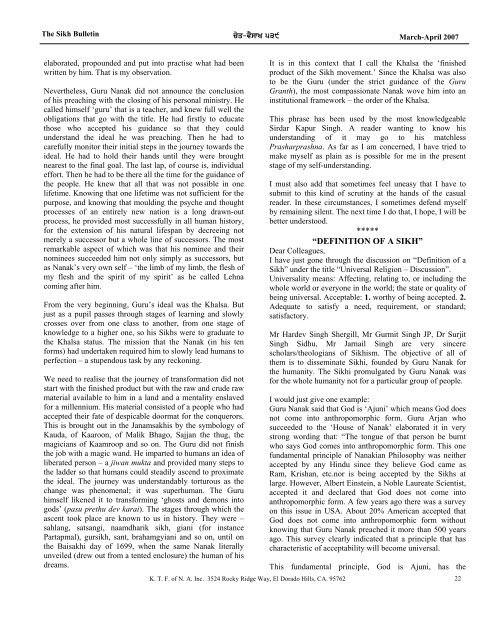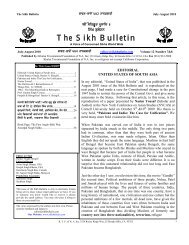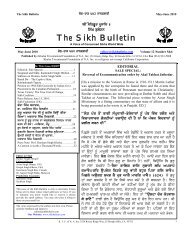You also want an ePaper? Increase the reach of your titles
YUMPU automatically turns print PDFs into web optimized ePapers that Google loves.
<strong>The</strong> <strong>Sikh</strong> <strong>Bulletin</strong> cyq-vYswK 539 March-April 2007<br />
elaborated, propounded and put into practise what had been<br />
written by him. That is my observation.<br />
Nevertheless, Guru Nanak did not announce the conclusion<br />
of his preaching with the closing of his personal ministry. He<br />
called himself ‘guru’ that is a teacher, and knew full well the<br />
obligations that go with the title. He had firstly to educate<br />
those who accepted his guidance so that they could<br />
understand the ideal he was preaching. <strong>The</strong>n he had to<br />
carefully monitor their initial steps in the journey towards the<br />
ideal. He had to hold their hands until they were brought<br />
nearest to the final goal. <strong>The</strong> last lap, of course is, individual<br />
effort. <strong>The</strong>n he had to be there all the time for the guidance of<br />
the people. He knew that all that was not possible in one<br />
lifetime. Knowing that one lifetime was not sufficient for the<br />
purpose, and knowing that moulding the psyche and thought<br />
processes of an entirely new nation is a long drawn-out<br />
process, he provided most successfully in all human history,<br />
for the extension of his natural lifespan by decreeing not<br />
merely a successor but a whole line of successors. <strong>The</strong> most<br />
remarkable aspect of which was that his nominee and their<br />
nominees succeeded him not only simply as successors, but<br />
as Nanak’s very own self – ‘the limb of my limb, the flesh of<br />
my flesh and the spirit of my spirit’ as he called Lehna<br />
coming after him.<br />
From the very beginning, Guru’s ideal was the Khalsa. But<br />
just as a pupil passes through stages of learning and slowly<br />
crosses over from one class to another, from one stage of<br />
knowledge to a higher one, so his <strong>Sikh</strong>s were to graduate to<br />
the Khalsa status. <strong>The</strong> mission that the Nanak (in his ten<br />
forms) had undertaken required him to slowly lead humans to<br />
perfection – a stupendous task by any reckoning.<br />
We need to realise that the journey of transformation did not<br />
start with the finished product but with the raw and crude raw<br />
material available to him in a land and a mentality enslaved<br />
for a millennium. His material consisted of a people who had<br />
accepted their fate of despicable doormat for the conquerors.<br />
This is brought out in the Janamsakhis by the symbology of<br />
Kauda, of Kaaroon, of Malik Bhago, Sajjan the thug, the<br />
magicians of Kaamroop and so on. <strong>The</strong> Guru did not finish<br />
the job with a magic wand. He imparted to humans an idea of<br />
liberated person – a jiwan mukta and provided many steps to<br />
the ladder so that humans could steadily ascend to proximate<br />
the ideal. <strong>The</strong> journey was understandably torturous as the<br />
change was phenomenal; it was superhuman. <strong>The</strong> Guru<br />
himself likened it to transforming ‘ghosts and demons into<br />
gods’ (pasu prethu dev karai). <strong>The</strong> stages through which the<br />
ascent took place are known to us in history. <strong>The</strong>y were –<br />
sahlang, satsangi, naamdharik sikh, giani (for instance<br />
Partapmal), gursikh, sant, brahamgyiani and so on, until on<br />
the Baisakhi day of 1699, when the same Nanak literally<br />
unveiled (drew out from a tented enclosure) the human of his<br />
dreams.<br />
It is in this context that I call the Khalsa the ‘finished<br />
product of the <strong>Sikh</strong> movement.’ Since the Khalsa was also<br />
to be the Guru (under the strict guidance of the Guru<br />
Granth), the most compassionate Nanak wove him into an<br />
institutional framework – the order of the Khalsa.<br />
This phrase has been used by the most knowledgeable<br />
Sirdar Kapur Singh. A reader wanting to know his<br />
understanding of it may go to his matchless<br />
Prasharprashna. As far as I am concerned, I have tried to<br />
make myself as plain as is possible for me in the present<br />
stage of my self-understanding.<br />
I must also add that sometimes feel uneasy that I have to<br />
submit to this kind of scrutiny at the hands of the casual<br />
reader. In these circumstances, I sometimes defend myself<br />
by remaining silent. <strong>The</strong> next time I do that, I hope, I will be<br />
better understood.<br />
*****<br />
“DEFINITION OF A SIKH”<br />
Dear Colleagues,<br />
I have just gone through the discussion on “Definition of a<br />
<strong>Sikh</strong>” under the title “Universal Religion – Discussion”.<br />
Universality means: Affecting, relating to, or including the<br />
whole world or everyone in the world; the state or quality of<br />
being universal. Acceptable: 1. worthy of being accepted. 2.<br />
Adequate to satisfy a need, requirement, or standard;<br />
satisfactory.<br />
Mr Hardev Singh Shergill, Mr Gurmit Singh JP, Dr Surjit<br />
Singh Sidhu, Mr Jarnail Singh are very sincere<br />
scholars/theologians of <strong>Sikh</strong>ism. <strong>The</strong> objective of all of<br />
them is to disseminate <strong>Sikh</strong>i, founded by Guru Nanak for<br />
the humanity. <strong>The</strong> <strong>Sikh</strong>i promulgated by Guru Nanak was<br />
for the whole humanity not for a particular group of people.<br />
I would just give one example:<br />
Guru Nanak said that God is ‘Ajuni’ which means God does<br />
not come into anthropomorphic form. Guru Arjan who<br />
succeeded to the ‘House of Nanak’ elaborated it in very<br />
strong wording that: “<strong>The</strong> tongue of that person be burnt<br />
who says God comes into anthropomorphic form. This one<br />
fundamental principle of Nanakian Philosophy was neither<br />
accepted by any Hindu since they believe God came as<br />
Ram, Krishan, etc.nor is being accepted by the <strong>Sikh</strong>s at<br />
large. However, Albert Einstein, a Noble Laureate Scientist,<br />
accepted it and declared that God does not come into<br />
anthropomorphic form. A few years ago there was a survey<br />
on this issue in USA. About 20% American accepted that<br />
God does not come into anthropomorphic form without<br />
knowing that Guru Nanak preached it more than 500 years<br />
ago. This survey clearly indicated that a principle that has<br />
characteristic of acceptability will become universal.<br />
This fundamental principle, God is Ajuni, has the<br />
K. T. F. of N. A. Inc. 3524 Rocky Ridge Way, El Dorado Hills, CA. 95762 22
















